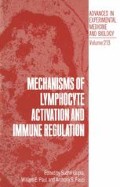Abstract
B cells, which are responsible for the secretion of antibodies, originate from pluripotent hematopoietic stem cells and differentiation stages, such as pre-B cells, mature B cells, activated B cells and antibody secreting cells. The commitment of each B cell clone to a specific antigen occurs at the pre-B cell level and mature B cells express IgM molecules as antigen receptors on their surface. Binding of an antigen complementary to the receptors of a certain B cell clone initiates a complex series of the activation process resulting into antibody secreting cells. This process of clonal expansion and differentiation requires the collaboration of helper T cells. Recently, the T cell-dependent activation process of B cells into antibody secreting cells has been extensively studied and the involvement of B cell specific growth and differentiation factors in this process has been demonstrated (1,2). The results are schematically summarized in Fig. 1.
Access this chapter
Tax calculation will be finalised at checkout
Purchases are for personal use only
Preview
Unable to display preview. Download preview PDF.
References
Miller and W. E. Paul. Regulation of B-cell growth and differentiation by soluble factors. Annual Rev. Immunol. 1:307 (1983).
T. Kishimoto. Factors affecting B cell growth and differentiation. Annu. Rev. Immunol. 3:135 (1985).
E. M. Rabin, J. Ohara, and W. E. Paul. B-cell stimulatory factor 1 activates resting B cells. Proc. Natl. Acad. Sci. USA. 82:2935, (1985).
T. Kishimoto, K. Yoshizaki, M. Kimoto, M. Okada, T. Kuritani, H. Kikutani, K. Shimizu, T. Nakagawa, N. Nakagawa, Y. Miki, H. Kishi, K. Fukunaga, T. Yoshikubo, and T. Taga. B cell growth and differentiation factors and mechanism of B cell activation. Immunol. Rev. 78:97, (1984).
T. Hirano, T. Taga, N. Nakano, K. Yasukawa, S. Kashiwamura, K. Shimizu, K. Nakajima, K. H. Pyun, and T. Kishimoto. Purification homogeneity and characterization of human B celL differentiation factor (BCDF or BSFp-2). Proc. Natl. Acad. Sci. USA. 82:5490(1985).
S. Maruyama, T. Naito, H. Kakita, S. Kishimoto, Y. Yamamura, and T. Kishimoto. Preparation of a monoclonal antibody against human monocyte. J. Clin. Immunol. 3:57, (1983).
H. Kikutani, R. Kimura, H. Nakamura, R. Sato, A. Muraguchi, N. Kawamura, R. R. Hardy, and T. Kishimoto. Expression and function of an early activation marker restricted to human B cells. L Immunol, (in press).
D. R. Parks, R. R. Hardy, and L. A. Herzenberg. Dual Immunofluorescence-News frontiers in cell analysis and sorting. Immunol. Today. 4:145 (1983).
S. Hashida, M. Imagawa, S. Inoue, K. H. Ruan, and E. Ishikawa. More useful maleimide compounds for the conjugation of Fab’ to horseradish peroxidase through thiol groups in the hinge. J. Applied Biochemistry. 6:56 (1984).
W. E. Marzluff, and R. C. Huang. Transcription of RNA in isolated nuclie, In Transcription and translation ed. by Hames, B. D. and Higgins, S. J. pp 89–120, IRL Press, Oxford (1984).
H. Hidaka, M. Inagaki, S. Kawamoto, and Y. Sasaki. Isoquinolinesulfonamede, novel and potent inhibitors of cyclic nucleotide dependent protein kinase and protein kinase C. Biochemistry. 23:5036 (1984).
D. A. Cantrell, and K. A. Smith. Transient expression of interleukin 2 receptors Consequences for T cell growth. J. Exp. Med. 158:1895, (1983).
M. Howard, J. J. Farrar, M. Hilfiker, B. Johnson, K. Takatsu, T. Hamaoka, and W. E. Paul. Identification of a T cell-derived B cell growth factor distinct from interleukin 2. J. Exp. Med. 155:914 (1982).
M. Okada, N. Sakaguchi, N. Yoshimura, H. Hara, K. Shimizu, N. Yoshida, K. Yoshizaki, S. Kishimoto, Y. Yamamura, and T. Kishimoto. B cell growth factor (BCGF) and B cell differentiation factor from human T hybridomas: Two distinct kinds of BCGFs and their synergism in B cell proliferation. J. Exp. Med. 157:583 (1983).
J. Imboden, and J. Stobo. Transmembrane signalling by the T cell antigen receptor. Perturbation of the T3-antigen receptor complex generates inositol phosphates and releases calcium ions from intracellular stores. J. Exp. Med. 161:446 (1985).
A. Truneh, F. Albert, P. Golstein, and A. Schmit-Verhulst. Early steps of lymphocyte activation bypassed by synergy between calcium ionophores and phorbol ester. Nature 313:318 (1985).
K. M. Congreshall, and J. C. Cambier. B cell activation VIII. Membrane immunoglobulins transduce signals via activation of phosphatidylinositol hydrolysis. J. Immunol. 133:3382(1984).
M. G. S. JU. Sutton, L. Mercier, E. R. Giuliani, and J. T. Lie. Atrial Myxomas A review of clinical experience in 40 patients. Mavo Clin. Proc. 55:371 (1980).
A. Schimpl, and E. Wecker. Replacement of T cell function by a T cell product. Nature 237:15 (1972).
S. L. Swain, G. Dennert, J. F. Warner, and R. W. Dutton. Culture supernatants of a stimulated T-cell line have helper activity that acts synergistically with interleukin 2 in the response of B cell to antigen. Proc. Natl. Acad. Sci. 78:2517 (1981).
H. J. Leibson, P. Marrack, and J.W. Kappler. B cell helper factors. I. Requirement for both interleukin 2 and another 40,000 mol. wt. factor. J. Exp. Med. 154:1681 (1981).
Author information
Authors and Affiliations
Editor information
Editors and Affiliations
Rights and permissions
Copyright information
© 1987 Plenum Press, New York
About this chapter
Cite this chapter
Kishimoto, T., Hirano, T., Kikutani, H., Muraguchi, A. (1987). Delineation of Human B Cell Differentiation: Immunological and Molecular Characterization of Human B Cell Differentiation Factor (BSF-2). In: Gupta, S., Paul, W.E., Fauci, A.S. (eds) Mechanisms of Lymphocyte Activation and Immune Regulation. Advances in Experimental Medicine and Biology, vol 213. Springer, Boston, MA. https://doi.org/10.1007/978-1-4684-5323-2_17
Download citation
DOI: https://doi.org/10.1007/978-1-4684-5323-2_17
Publisher Name: Springer, Boston, MA
Print ISBN: 978-1-4684-5325-6
Online ISBN: 978-1-4684-5323-2
eBook Packages: Springer Book Archive

